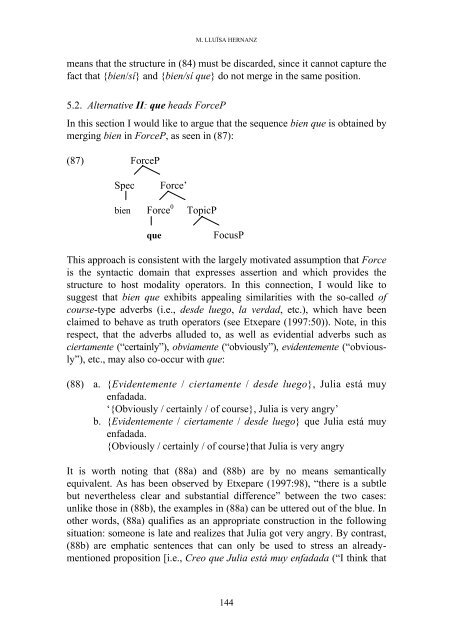Emphatic Polarity and C in Spanish - Lear
Emphatic Polarity and C in Spanish - Lear
Emphatic Polarity and C in Spanish - Lear
You also want an ePaper? Increase the reach of your titles
YUMPU automatically turns print PDFs into web optimized ePapers that Google loves.
M. LLUÏSA HERNANZ<br />
means that the structure <strong>in</strong> (84) must be discarded, s<strong>in</strong>ce it cannot capture the<br />
fact that {bien/sí} <strong>and</strong> {bien/sí que} do not merge <strong>in</strong> the same position.<br />
5.2. Alternative II: que heads ForceP<br />
In this section I would like to argue that the sequence bien que is obta<strong>in</strong>ed by<br />
merg<strong>in</strong>g bien <strong>in</strong> ForceP, as seen <strong>in</strong> (87):<br />
(87) ForceP<br />
Spec Force’<br />
bien Force 0 TopicP<br />
que FocusP<br />
This approach is consistent with the largely motivated assumption that Force<br />
is the syntactic doma<strong>in</strong> that expresses assertion <strong>and</strong> which provides the<br />
structure to host modality operators. In this connection, I would like to<br />
suggest that bien que exhibits appeal<strong>in</strong>g similarities with the so-called of<br />
course-type adverbs (i.e., desde luego, la verdad, etc.), which have been<br />
claimed to behave as truth operators (see Etxepare (1997:50)). Note, <strong>in</strong> this<br />
respect, that the adverbs alluded to, as well as evidential adverbs such as<br />
ciertamente (“certa<strong>in</strong>ly”), obviamente (“obviously”), evidentemente (“obviously”),<br />
etc., may also co-occur with que:<br />
(88) a. {Evidentemente / ciertamente / desde luego}, Julia está muy<br />
enfadada.<br />
‘{Obviously / certa<strong>in</strong>ly / of course}, Julia is very angry’<br />
b. {Evidentemente / ciertamente / desde luego} que Julia está muy<br />
enfadada.<br />
{Obviously / certa<strong>in</strong>ly / of course}that Julia is very angry<br />
It is worth not<strong>in</strong>g that (88a) <strong>and</strong> (88b) are by no means semantically<br />
equivalent. As has been observed by Etxepare (1997:98), “there is a subtle<br />
but nevertheless clear <strong>and</strong> substantial difference” between the two cases:<br />
unlike those <strong>in</strong> (88b), the examples <strong>in</strong> (88a) can be uttered out of the blue. In<br />
other words, (88a) qualifies as an appropriate construction <strong>in</strong> the follow<strong>in</strong>g<br />
situation: someone is late <strong>and</strong> realizes that Julia got very angry. By contrast,<br />
(88b) are emphatic sentences that can only be used to stress an alreadymentioned<br />
proposition [i.e., Creo que Julia está muy enfadada (“I th<strong>in</strong>k that<br />
144

















